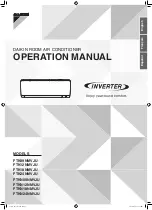
OCH791 _18
5-5. Correcting capacity for changes in the length of refrigerant piping
During cooling, obtain the ratio (and the piping equivalent length) of the outdoor units rated capacity and the total in-use
indoor capacity, and find the capacity ratio corresponding to the standard piping length from Figure 5 to 7. Then multiply
by the cooling capacity from Figure 1 and 2 in “4-2. Correction by temperature” to obtain the actual capacity.
During heating, find the piping equivalent length, and find the capacity ratio corresponding to standard piping length from
Figure 8. Then multiply by the heating capacity from Figure 3 and 4 in “4-2. Correction by temperature” to obtain the actu-
al capacity.
■
Capacity Correction Curve
5-5-1. Cooling
11.2
16.8
22.4
29.1
Total capacity of indoor unit
Cooling capacity correction factor
Piping equivalent length (m)
0
5 10 15 20 25 30 35 40 45 50 55 60 65 70 75 80 85 90
0.70
0.75
0.80
0.85
0.90
0.95
1.00
<Figure 5> Correction of refrigerant piping length
5-5-2. Heating
Heating
P200 model
Total capacity of indoor unit
Cooling capacity correction factor
Piping equivalent length (m)
0
5 10 15 20 25 30 35 40 45 50 55 60 65 70 75 80 85 90
0.70
0.75
0.80
0.85
0.90
0.95
1.00
<Figure 6> Correction of refrigerant piping length
■
Method for obtaining the piping equivalent length
Piping equivalent length = piping length to the farthest indoor unit + 0.3 × number of bends in the piping (m)
5-5-3. Correction of heating capacity for frost and defrosting
If heating capacity has been reduced due to frost formation or defrosting, multiply the capacity by the appropriate correc-
tion factor from the following table to obtain the actual heating capacity.
















































